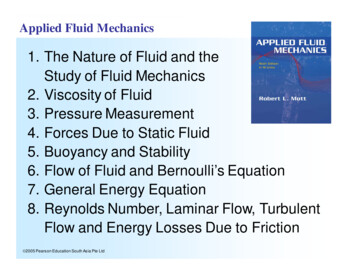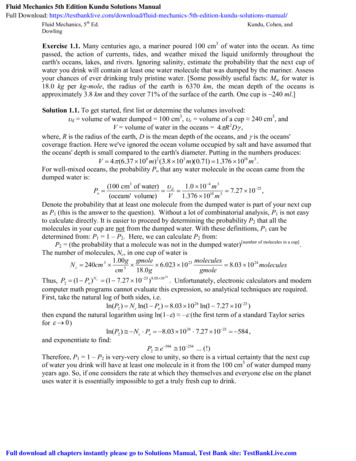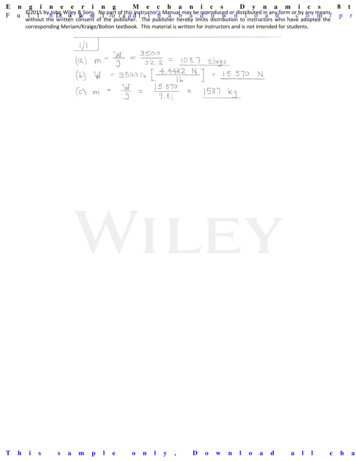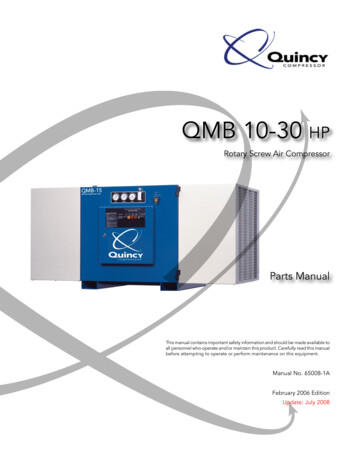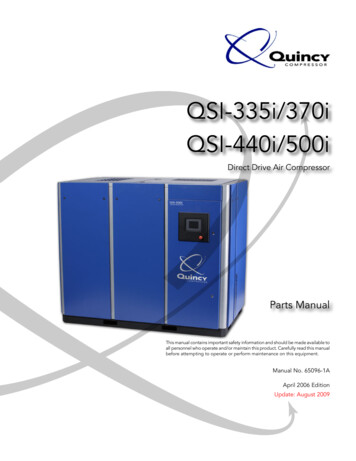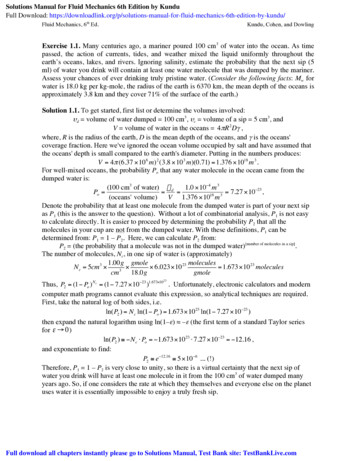
Transcription
Solutions Manual for Fluid Mechanics 6th Edition by KunduFull Download: uid-mechanics-6th-edition-by-kundu/Fluid Mechanics, 6th Ed.Kundu, Cohen, and DowlingExercise 1.1. Many centuries ago, a mariner poured 100 cm3 of water into the ocean. As timepassed, the action of currents, tides, and weather mixed the liquid uniformly throughout theearth’s oceans, lakes, and rivers. Ignoring salinity, estimate the probability that the next sip (5ml) of water you drink will contain at least one water molecule that was dumped by the mariner.Assess your chances of ever drinking truly pristine water. (Consider the following facts: Mw forwater is 18.0 kg per kg-mole, the radius of the earth is 6370 km, the mean depth of the oceans isapproximately 3.8 km and they cover 71% of the surface of the earth.)Solution 1.1. To get started, first list or determine the volumes involved:υd volume of water dumped 100 cm3, υc volume of a sip 5 cm3, andV volume of water in the oceans 4 πR 2 Dγ ,where, R is the radius of the earth, D is the mean depth of the oceans, and γ is the oceans'coverage fraction. Here we've ignored the ocean volume occupied by salt and have assumed thatthe oceans' depth is small compared to the earth's diameter. Putting in the numbers produces: V 4 π (6.37 10 6 m) 2 (3.8 10 3 m)(0.71) 1.376 1018 m 3 .For well-mixed oceans, the probability Po that any water molecule in the ocean came from thedumped water is:(100 cm3 of water) υ d1.0 10 4 m 3Po 7.27 10 23 , 183(oceans' volume)V 1.376 10 mDenote the probability that at least one molecule from the dumped water is part of your next sipas P1 (this is the answer to the question). Without a lot of combinatorial analysis, P1 is not easyto calculate directly. It is easier to proceed by determining the probability P2 that all the in your cup are not from the dumped water. With these definitions, P can bemolecules1determined from: P1 1 – P2. Here, we can calculate P2 from:P2 (the probability that a molecule was not in the dumped water)[number of molecules in a sip].The number of molecules, Nc, in one sip of water is (approximately)1.00g gmolemoleculesN c 5cm 3 6.023 10 23 1.673 10 23 molecules3cm18.0ggmole23 Thus, P2 (1 Po ) Nc (1 7.27 10 23 )1.673 10 . Unfortunately, electronic calculators and moderncomputer math programs cannot evaluate this expression, so analytical techniques are required.First, take the natural log of both sides, i.e.ln(P2 ) N c ln(1 Po ) 1.673 10 23 ln(1 7.27 10 23 )then expand the natural logarithm using ln(1–ε) –ε (the first term of a standard Taylor seriesfor ε 0 )ln(P2 ) N c Po 1.673 10 23 7.27 10 23 12.16 ,and exponentiate to find:P2 e 12.16 5 10 6 . (!)Therefore, P1 1 – P2 is very close to unity, so there is a virtual certainty that the next sip ofwater you drink will have at least one molecule in it from the 100 cm3 of water dumped manyyears ago. So, if one considers the rate at which they themselves and everyone else on the planetuses water it is essentially impossible to enjoy a truly fresh sip.Full download all chapters instantly please go to Solutions Manual, Test Bank site: TestBankLive.com
Fluid Mechanics, 6th Ed.Kundu, Cohen, and DowlingExercise 1.2. An adult human expels approximately 500 ml of air with each breath duringordinary breathing. Imagining that two people exchanged greetings (one breath each) manycenturies ago, and that their breath subsequently has been mixed uniformly throughout theatmosphere, estimate the probability that the next breath you take will contain at least one airmolecule from that age-old verbal exchange. Assess your chances of ever getting a truly freshbreath of air. For this problem, assume that air is composed of identical molecules having Mw 29.0 kg per kg-mole and that the average atmospheric pressure on the surface of the earth is 100kPa. Use 6370 km for the radius of the earth and 1.20 kg/m3 for the density of air at roomtemperature and pressure.Solution 1.2. To get started, first determine the masses involved.m mass of air in one breath density x volume (1.20kg /m 3 )(0.5 10 3 m 3 ) 0.60 10 3 kg M mass of air in the atmosphere 4 πR2 ρ(z)dzz 0Here, R is the radius of the earth, z is the elevationabove the surface of the earth, and ρ(z) is the air density as function of elevation. From the law for static pressure in a gravitational field,z Ps, on the earth is determined from Ps P dP dz ρg , the surface pressure, ρ(z)gdz soz 0Ps P (10 5 Pa) 4π (6.37 10 6 m)2 5.2 1018 kg . 2g9.81mswhere the pressure (vacuum) in outer space P 0, and g is assumed constant throughout theatmosphere. For a well-mixed atmosphere, the probability Po that any molecule in theatmosphere came from the age-old verbal exchange is2 (mass of one breath)2m 1.2 10 3 kgPo 2.31 10 22 ,18(mass of the whole atmosphere) M 5.2 10 kgwhere the factor of two comes from one breath for each person. Denote the probability that atleast one molecule from the age-old verbal exchange is part of your next breath as P1 (this is theanswer to the question). Without a lot of combinatorial analysis, P1 is not easy to calculate directly.It is easier to proceed by determining the probability P2 that all the molecules in yournext breath are not from the age-old verbal exchange. With these definitions, P1 can bedetermined from: P1 1 – P2. Here, we can calculate P2 from:P2 (the probability that a molecule was not in the verbal exchange)[number of molecules in one breath].The number of molecules, Nb, involved in one breath is0.6 10 3 kg 10 3 gmoleculesNb 6.023 10 23 1.25 10 22 molecules29.0g /gmolekggmoleNb 22 1.25 10 22Thus, P2 (1 Po ) (1 2.31 10 ). Unfortunately, electronic calculators and moderncomputer math programs cannot evaluate this expression, so analytical techniques are required.First, take the natural log of both sides, i.e.ln(P2 ) N b ln(1 Po ) 1.25 10 22 ln(1 2.31 10 22 ) then expand the natural logarithm using ln(1–ε) –ε (the first term of a standard Taylor seriesfor ε 0 )ln(P2 ) N b Po 1.25 10 22 2.31 10 22 2.89 , and exponentiate to find:M 4π R 2that:
Fluid Mechanics, 6th Ed.Kundu, Cohen, and DowlingP2 e 2.89 0.056 .Therefore, P1 1 – P2 0.944 so there is a better than 94% chance that the next breath you takewill have at least one molecule in it from the age-old verbal exchange. So, if one considers howoften they themselves and everyone else breathes, it is essentially impossible to get a breath of truly fresh air.
Fluid Mechanics, 6th Ed.Kundu, Cohen, and DowlingExercise 1.3. The Maxwell probability distribution, f(v) f(v1,v2,v3), of molecular velocities in agas flow at a point in space with average velocity u is given by (1.1).a) Verify that u is the average molecular velocity, and determine the standard deviations (σ1,12#1&23σ2, σ3) of each component of u using σ i % (vi ui ) f (v)d v( for i 1, 2, and 3. n all v'b) Using (1.27) or (1.28), determine n N/V at room temperature T 295 K and atmosphericpressure p 101.3 kPa.c) Determine N nV number of molecules in volumes V (10 µm)3, 1 µm3, and (0.1 µm)3.d) For the ith velocity component, the standard deviation of the average, σa,i, over N moleculesis σa,i σ i N when N 1. For an airflow at u (1.0 ms–1, 0, 0), compute the relativeuncertainty, 2σ a,1 u1 , at the 95% confidence level for the average velocity for the three volumeslisted in part c).e) For the conditions specified in parts b) and d), what is the smallest volume of gas that ensuresa relative uncertainty in U of one percent or less?Solution 1.3. a) Use the given distribution, and the definition of an average:32" m % * m123(v)ave v f (v)d v v u . d 3v .' v exp n all u# 2π kBT & , 2kBT/Consider the first component of v, and separate out the integrations in the "2" and "3" directions.32! m . m1* (v1 u1 )2 (v2 u2 )2 (v3 u3 )2 ,-2 dv1dv2 dv3(v1 )ave #& v1 exp / " 2π kBT % 0 2kBT33 2 ! m #&" 2 π k BT %* m(v1 u1 )2 - * m(v2 u2 )2 - * m(v3 u3 )2 vexp dvexp dvexp . . 1 , 2k T / 1 , 2k T / 2 , 2k T ./dv3BBB 12The integrations in the "2" and "3" directions are equal to: (2πk B T m) , so1 2 ! m (v1 )ave #&" 2 π k BT %* m(v1 u1 )2 . dv12kBT / v exp , 1 12 The change of integration variable to β (v1 u1 ) ( m 2kBT ) changes this integral to:! ! 2k T 1 2 1 ## β #" mB &% u1 && exp { β 2 } d β 0 π u1 π u1 ,% "where the first term of the integrand is an odd function integrated on an even interval so itscontribution is zero. This procedure is readily repeated for the other directions to find (v2)ave u2,and (v3)ave u3. Thus, u (u1, u2, u3) is the average molecular velocity.Using the same simplifications and change of integration variables produces:32! m . m122* (v1 u1 )2 (v2 u2 )2 (v3 u3 )2 ,-2 dv1dv2 dv3σ1 #& (v1 u1 ) exp / " 2π kBT % 0 2kBT31(v1 )ave π1 2 ! m #&" 2 π k BT % * m(v1 u1 )2 1 ! 2kBT 2 (v1 u1 ) exp , 2k T ./ dv1 π #" m &% β exp { β 2 } d β .B 2
Fluid Mechanics, 6th Ed.Kundu, Cohen, and DowlingThe final integral over β is:π 2 , so the standard deviations of molecular speed are12σ1 ( k B T m) σ 2 σ 3 ,where the second two equalities follow from repeating this calculation for the second and thirddirections. b) From (1.27), n V p kBT (101.3kPa) [1.381 10 23 J / K 295K ] 2.487 10 25 m 3 n 2.487 1010 for V 103 µm3 10–15 m3c) From n/V from part b):n 2.487 10 7 for V 1.0 µm3 10–18 m3n 2.487 10 4 for V 0.001 µm3 10–21 m3d) From (1.29), the gas constant is R (kB/m), and R 287 m2/s2K for air. Compute: 1212122σ a,1 u1 2 ( kBT m n ) [1m / s ] 2 ( RT n ) 1m / s 2 ( 287 295 n ) 582 n . Thus,forV 10–15 m3 : 2σ a,1 u1 0.00369,–183V 10 m : 2σ a,1 u1 0.117, andV 10–21 m3 : 2σ a,1 u1 3.69.e) To achieve a relative uncertainty of 1% we need n (582/0.01)2 3.39 109, and thiscorresponds to a volume of 1.36 10-16 m3 which is a cube with side dimension 5 µm.
Fluid Mechanics, 6th Ed.Kundu, Cohen, and DowlingExercise 1.4. Using the Maxwell molecular speed distribution given by (1.4),a) determine the most probable molecular speed,b) show that the average molecular speed is as given in (1.5),12#1 &c) determine the root-mean square molecular speed vrms % 0 v 2 f (v)dv( , n'd) and compare the results from parts a), b) and c) with c speed of sound in a perfect gasunder the same conditions.Solution 1.4. a) The most probable speed, vmp, occurs where f(v) is maximum. Thus, differentiate(1.4) with respect v, set this derivative equal to zero, and solve for vmp. Start from:32! m 2( mv 2 f (v) 4π n #, , and differentiate& v exp ) " 2 π k BT %* 2kBT 322 ,3(* mvmp(* mv 2 ,*2! m /* mvmpdf 4π n #exp ) mp -4 0- & 12vmp exp ) dv" 2π kBT % 10 * 2kBT .* kBT * 2kBT .*43Divide out common factors to find:mv 22kBT.2 mp 0 or vmp mk BTb) From (1.5), the average molecular speed v is given by:32# m & 3* mv 2 1 v v f (v)dv 4π %. dv .( v exp n 0 2 π k BT ' 0, 2kBT /Change the integration variable to β mv 2 2kBT to simplify the integral:121212! m k BT ! 8kBT ! 8kBT β β v 4#& β exp { β } d β #" π m &% ( β e e )0 #" π m &% ," 2 π k BT % m 0and this matches the result provided in (1.5).c) The root-mean-square molecular speed vrms is given by:32# m & 4* mv 2 1 22vrms v f (v)dv 4π %. dv .( v exp n 0 2 π k BT ' 0, 2kBT /12Change the integration variable to β v ( m 2kBT )to simplify the integral:12 4 ! 2kBT 4 ! 2kBT 3 π 3kBT42. #& β exp { β } d β #&mπ" m % 0π" m % 8Thus, vrms (3kBT/m)1/2.d) From (1.28), R (kB/m) so vmp 2RT , v (8 / π )RT , and vrms 3RT . All three speeds2vrms have the same temperature dependence the speed of sound in a perfect gas: c γRT , but arefactors of2γ,8 πγ and3 γ , respectively, larger than c.
Fluid Mechanics, 6th Ed.Kundu, Cohen, and DowlingExercise 1.5. By considering the volume swept out by a moving molecule, estimate how themean-free path, l, depends on the average molecular cross section dimension d and themolecular number density n for nominally spherical molecules. Find a formula for ln1 3 (the ratioof the mean-free path to the mean intermolecular spacing) in terms of the nominal molecularvolume ( d 3 ) and the available volume per molecule (1/n). Is this ratio typically bigger or smallerthan one? Solution 1.5. The combined collision cross section for two spherical molecules having diameterd is πd 2 . The mean free path l is the average distance traveled by a molecule betweencollisions. Thus, the average molecule should experience onecollision when sweeping a volume equal to πd 2 l . If the molecularnumber density is n, then the volume per molecule is n–1, and thedmean intermolecular spacing is n–1/3. Assuming that the swept volumenecessary to produce one collision is proportional to the volume per molecule produces:2π d l C n or l C ( nπ d 2 ) , where C is a dimensionless constant presumed to be of order unity. The dimensionless version ofthis equation is:mean free pathl 1 3 l n1 3mean intermolecular spacing n" n 1 %CC 23 2 C 3'3 23n πd#d &nd( )2323" volume per molecule % C ' ,# molecular volume &where all numerical constants like π have been combined into C. Under ordinary conditions ingases, the molecules are not tightly packed so l n 1 3 . In liquids, the molecules are tightlypacked so l n 1 3 .
Fluid Mechanics, 6th Ed.Kundu, Cohen, and DowlingExercise 1.6. Compute the average relative speed, vr , between molecules in a gas using theMaxwell speed distribution f given by (1.4) via the following steps.a) If u and v are the velocities of two molecules then their relative velocity is: vr u – v. If theangle between u and v is θ, show that the relative speed is: vr vr u 2 v 2 2uv cosθ whereu u , and v v .b) The averaging of vr necessary to determine vr must include all possible values of the twospeeds (u and v) and all possible angles θ. Therefore, start from:1vr 2 vr f (u) f (v)sin θ dθ dvdu ,2n all u,v,θand note that vr is unchanged by exchange of u and v, to reach:1 π u2 v2 2uv cosθ sinθ f (u) f (v)dθ dvdun 2 u 0 v u θ 0c) Note that vr must always be positive and perform the integrations, starting with the angularone, to find:12# 16k T &1 2u3 6uv 2vr 2 f (u) f (v)dvdu % B ( 2 v . π '3n u 0 v uuvvr Solution 1.6. a) Compute the dot produce of vr with itself:2v r v r v r (u v) (u v) u u 2u v v v u 2 2uv cosθ v 2 .Take the square root to find: vr u 2 v 2 2uv cosθ .b) The average relative speed must account for all possible molecular speeds and all possibleangles between the two molecules. [The coefficient 1/2 appears in the first equality belowbecause the probability density function of for the angle θ in the interval 0 θ π is (1/2)sinθ.]1vr 2 vr f (u) f (v)sin θ dθ dvdu2n all u,v,θ u 2 v 2 2uv cosθ f (u) f (v)sin θ dθ dvdu1 π 2 u 2 v 2 2uv cosθ sin θ f (u) f (v)dθ dvdu.2n u 0 v 0 θ 0In u-v coordinates, the integration domain covers the firstquadrant, and the integrand is unchanged when u and v arev! dv!swapped. Thus, the u-v integration can be completed above theline u v if the final result is doubled. Thus,1 πvr 2 u 2 v 2 2uv cosθ sin θ f (u) f (v)dθ dvdu .n u 0 v u θ 0Now tackle the angular integration, by settingβ u 2 v 2 2uv cosθ so that d β 2uvsin θ dθ . This leads to21 (v u)dβvr 2 β 1 2f (u) f (v)dvdu ,n u 0 v u β (v u)22uvv!all u,v,θ 12n 2u du!u!
Fluid Mechanics, 6th Ed.Kundu, Cohen, and Dowlingand the β-integration can be performed:1 2 3 2 (v u)2 f (u) f (v)1 f (u) f (v)vr 2 βdvdu 2 (v u)3 (v u)3dvdu .2(v u)2n u 0 v u 3uv3n u 0 v uuvExpand the cubic terms, simplify the integrand, and prepare to evaluate the v-integration:1 f (v) f (u)vr 2 2u3 6uv 2dvdu3n u 0 v uvu( )(())32# m & 2* mv 2 - f (u)1 32 4π (2u 6uv ) v % 2π k T (' v exp , 2k T ./ dv u du.3n u 0 v uBBUse the variable substitution: α mv2/2kBT so that dα mvdv/kBT, which reduces the vintegration to:321 ! 3k BT ! m kTf (u)vr α &4 π #du& exp { α } B dα# 2u 6u 3n u 0 mu2 kBT "m % " 2 π k BT %mu12 2! m #&3n " 2π kBT % ! 3k T αf (u)du# 2u 6u B α &e dα"m %uu 0 mu2 kBT 12 2! m #&3n " 2π kBT % ! kTf (u) #" 2u3e α 6u mB ( α e α e α )&% 2 u dumu kBTu 012! mu 2 f (u)2! m ! 3k BT #8u 12uexpdu.& ## &&3n " 2π kBT % u 0 "m %" 2kBT % uThe final u-integration may be completed by substituting in for f(u) and using the variable12substitution γ u ( m kBT ) .12 3232! ! k T 3 2! k BT ! m ! k BT 3B ##8#" m &% γ 12 #" m &% γ &&4π #" 2π k T &% #" m &%γ exp ( γ 2 ) dγ%B0 "1 ! 2m vr #&3 " π k BT %12 2 !k T # B &3π " m %12 2 !k T ! 31 (8γ 12γ ) exp ( γ ) dγ 3π #" mB &% #"8 8 π 12 4 π &%04122122! 16k T 4 ! k BT #& # B & 2v" πm %π" m %Here, v is the mean molecular speed from (1.5).
Fluid Mechanics, 6th Ed.Kundu, Cohen, and DowlingExercise 1.7. In a gas, the molecular momentum flux (MFij) in the j-coordinate direction thatcrosses a flat surface of unit area with coordinate normal direction i is:1MFij mvi v j f (v)d 3v where f(v) is the Maxwell velocity distribution (1.1). For a perfectV all vgas that is not moving on average (i.e., u 0), show that MFij p (the pressure), when i j, andthat MFij 0, when i j.Solution 1.7. Start from the given equation using the Maxwell distribution:32* m1nm " m % 3MFij mvi v j f (v)d v v12 v22 v32 ). dv1dv2 dv3 ' vi v j exp (V all uV # 2π kBT & , 2kBT/and first consider i j 1, and recognize ρ nm/V as the gas density, as in (1.28).32! m 2* mMF11 ρ #v12 v22 v32 ). dv1dv2 dv3& u1 exp (" 2π kBT % , 2kBT/3 2 ! m ρ#&" 2 π k BT %21 v ( mv12 ( mv22 ( mv32 exp ) , dv1 exp ) , dv2 exp ) ,dv3* 2kBT - * 2kBT * 2kBT The first integral is equal to ( 2kBT m )( 2 π k BT32()π 2 while the second two integrals are each equal to12m ) . Thus:32! m ! 2kBT 3 2 π ! 2π kBT 1 2 ! 2π kBT 1 2kTMF11 ρ #& #&#& #& ρ B ρ RT p2 " m % " m %m" 2 π k BT % " m %where kB/m R from (1.28). This analysis may be repeated with i j 2, and i j 3 to find:MF22 MF33 p, as well.Now consider the case i j. First note that MFij MFji because the velocity product underthe triple integral may be written in either order vivj vjvi, so there are only three cases ofinterest. Start with i 1, and j 2 to find:32! m * mMF12 ρ #v12 v22 v32 ). dv1dv2 dv3& v1v2 exp (" 2π kBT % , 2kBT/32! m ( mv12 ( mv22 ( mv32 ρ#, dv1 v2 exp ) , dv2 exp ) ,dv3& v1 exp ) " 2π kBT % * 2kBT - * 2kBT * 2kBT Here we need only consider the first integral. The integrand of this integral is an odd functionbecause it is product of an odd function, v1, and an even function, exp { mv12 2kBT } . Theintegral of an odd function on an even interval [– , ] is zero, so MF12 0. And, this analysismay be repeated for i 1 and j 3, and i 2 and j 3 to find MF13 MF23 0.
Fluid Mechanics, 6th Ed.Kundu, Cohen, and DowlingExercise 1.8. Consider the viscous flow in a channel of width 2b. The channel is aligned in thex-direction, and the velocity u in the x-direction at a distance y from the channel centerline is2given by the parabolic distribution u(y) U 0 1 ( y b) . Calculate the shear stress τ as a[]function y, µ, b, and Uo. What is the shear stress at y 0?* y '2dudy Solution 1.8. Start from (1.3): τ µ µ U o ,1 & ) / –2µU o 2 . At y 0 (the location ofdydy % b ( .bmaximum velocity) τ 0. At At y b (the locations of zero velocity), τ 2µ U o b .
Fluid Mechanics, 6th Ed.Kundu, Cohen, and DowlingExercise 1.9. Hydroplaning occurs on wet roadways when sudden braking causes a movingvehicle’s tires to stop turning when the tires are separated from the road surface by a thin film ofwater. When hydroplaning occurs the vehicle may slide a significant distance before the filmbreaks down and the tires again contact the road. For simplicity, consider a hypothetical versionof this scenario where the water film is somehow maintained until the vehicle comes to rest.a) Develop a formula for the friction force delivered to a vehicle of mass M and tire-contact areaA that is moving at speed u on a water film with constant thickness h and viscosity µ.b) Using Newton’s second law, derive a formula for the hypothetical sliding distance D traveledby a vehicle that started hydroplaning at speed Uoc) Evaluate this hypothetical distance for M 1200 kg, A 0.1 m2, Uo 20 m/s, h 0.1 mm, andµ 0.001 kgm–1s–1. Compare this to the dry-pavement stopping distance assuming a tire-roadcoefficient of kinetic friction of 0.8.Solution 1.9. a) Assume that viscous friction from the water layer transmitted to the tires is theonly force on the sliding vehicle. Here viscous shear stress at any time will be µu(t)/h, where u(t)is the vehicle's speed. Thus, the friction force will be Aµu(t)/h.duub) The friction force will oppose the motion so Newton’s second law implies: M Aµ .dthThis equation is readily integrated to find an exponential solution: u(t) Uo exp ( Aµt Mh ) ,where the initial condition, u(0) Uo, has been used to evaluate the constant of integration. Thedistance traveled at time t can be found from integrating the velocity:ttx(t) u(t!)dt! Uo exp ( Aµt! Mh ) dt! (Uo Mh Aµ ) %1 exp ( Aµt Mh )&' .ooThe total sliding distance occurs for large times where the exponential term will be negligible so:D Uo Mh Aµ2c) For M 1200 kg, A 0.1 m , Uo 20 m/s, h 0.1 mm, and µ 0.001 kgm–1s–1, the stoppingdistance is: D (20)(1200)(10–4)/(0.1)(0.001) 24 km! This is an impressively long distance andhighlights the dangers of driving quickly on water covered roads.For comparison, the friction force on dry pavement will be –0.8Mg, which leads to avehicle velocity of: u(t) Uo 0.8gt , and a distance traveled of x(t) Uot 0.4gt 2 . The vehiclestops when u 0, and this occurs at t Uo/(0.8g), so the stopping distance is2! Uo ! Uo Uo2,D Uo # 0.4g &#&" 0.8g %" 0.8g % 1.6gwhich is equal to 25.5 m for the conditions given. (This is nearly three orders of magnitude lessthan the estimated stopping distance for hydroplaning.)
Fluid Mechanics, 6th Ed.Kundu, Cohen, and DowlingExercise 1.10. Estimate the height to which water at 20 C will rise in a capillary glass tube 3mm in diameter that is exposed to the atmosphere. For water in contact with glass the contactangle is nearly 0 . At 20 C, the surface tension of a water-air interface is σ 0.073 N/m.Solution 1.10. Start from the result of Example 1.4.2σ cos α2(0.073N / m)cos(0 )h 9.92mm3ρ gR(10 kg / m 3 )(9.81m / s 2 )(1.5 10 3 m)
Fluid Mechanics, 6th Ed.Kundu, Cohen, and DowlingExercise 1.11. A manometer is a U-shaped tube containing mercury of density ρm. Manometersare used as pressure-measuring devices. If the fluid in tank A has a pressure p and density ρ, thenshow that the gauge pressure in the tank is: p patm ρmgh ρga. Note that the last term on theright side is negligible if ρ « ρm. (Hint: Equate the pressures at X and Y.)Solution 1.9. Start by equating the pressures at X and Y.pX p ρga patm ρmgh pY.Rearrange to find:p – patm ρmgh – ρga.
Fluid Mechanics, 6th Ed.Kundu, Cohen, and DowlingExercise 1.12. Prove that if e(T, υ) e(T) only and if h(T, p) h(T) only, then the (thermal)equation of state is (1.28) or pυ kT, where k is constant. Solution 1.12. Start with the first equation of (1.24): de Tds – pdυ, and rearrange it: s ' s '1pds de dυ & ) de & ) dυ ,% e (υ% υ ( eTTwhere the second equality holds assuming the entropy depends on e and υ. Here we see that:1 # s &p s ' % ( , and & ) .T e 'υT % υ ( e s ' ' s ' 'Equality of the crossed second derivatives of s, & & ) ) & & ) ) , implies:% υ % e (υ ( e % e % υ ( e (υ (1 T ) ' ( p T ) ' &) &) .% υ ( e % e (υ (1 T ) ' (1 T ) ' However, if e depends only on T, then ( / υ)e ( / υ)T, thus &) &) 0 , so% υ ( e % υ (T# ( p T) & %( 0 , which can be integrated to find: p/T f1(υ), where f1 is an undetermined function. e 'υNow repeat this procedure using the second equation of (1.24), dh Tds υdp.% s (% s (1υds dh dp ' * dh ' * dp .& h ) pTT& p ) h1 # s &υ % s (Here equality of the coefficients of the differentials implies: % ( , and ' * .T h ' pT & p ) h# (1 T ) &# (υ T ) & So, equality of the crossed second derivatives implies: %( %( . Yet, if h depends p ' h h ' p# (1 T ) & # (1 T ) & % (υ T ) (only on T, then ( / p)h ( / p)T, thus %( %( 0 , so '* 0 , which can p ' h p 'T& h ) p undetermined function.be integrated to find: υ/T f2(p), where f2 is anCollecting the two results involving f1 and f2, and solving for T produces:pυ T or pf 2 ( p) υf1 (υ ) k ,f1 (υ )f 2 ( p)where k must be is a constant since p and υ are independent thermodynamic variables.Eliminating f1 or f2 from either equation on the left, produces pυ kT.And finally, using both versions of (1.24) we can write: dh – de υdp pdυ d(pυ). When e and h only depend on T, then dh cpdT and de cvdT, sodh – de (cp – cv)dT d(pυ) kdT , thus k cp – cv R,where R is the gas constant. Thus, the final result is the perfect gas law: p kT/υ ρRT.
Fluid Mechanics, 6th Ed.Kundu, Cohen, and DowlingExercise 1.13. Starting from the property relationships (1.24) prove (1.31) and (1.32) for areversible adiabatic process involving a perfect gas when the specific heats cp and cv are constant.Solution 1.13. For an isentropic process: de Tds – pdυ –pdυ, and dh Tds υdp υdp.Equations (1.31) and (1.32) apply to a perfect gas so the definition of the specific heat capacities(1.20), and (1.21) for a perfect gas, dh cpdT, and de cvdT , can be used to form the ratiodh/de:dυdρ dpdh cp dT cpυ dp γ .or γ γ υρpde cv dT cvpdυThe final equality integrates to: ln(p) γln(ρ) const which can be exponentiated to find:p const.ργ,which is (1.31). The constant may be evaluated at a reference condition po and ρo to find:γp po ( ρ ρ o ) and this may be inverted to put the density ratio on the left1γ ρ ρ o ( p po ) ,which is the second equation of (1.32). The remaining relationship involving the temperature isfound by using the perfect gas law, p ρRT, to eliminate ρ p/RT:1γ 1 γ" p %(γ 1) γρp RT pTo # p &Tp" p%, % ( or ' 'ρ o po RTo poT po 'To po # po &# po &which is the first equation of (1.32).
Fluid Mechanics, 6th Ed.Kundu, Cohen, and DowlingExercise 1.14. A cylinder contains 2 kg of air at 50 C and a pressure of 3 bars. The air iscompressed until its pressure rises to 8 bars. What is the initial volume? Find the final volume forboth isothermal compression and isentropic compression.Solution 1.14. Use the perfect gas law but explicitly separate the mass M of the air and thevolume V it occupies via the substitution ρ M/V:p ρRT (M/V)RT.Solve for V at the initial time:Vi initial volume MRT/pi (2 kg)(287 m2/s2K)(273 50 )/(300 kPa) 0.618 m3.For an isothermal process:Vf final volume MRT/pf (2 kg)(287 m2/s2K)(273 50 )/(800 kPa) 0.232 m3.For an isentropic process:1γ1 1.4V f Vi ( pi p f ) 0.618m 3 (300kPa 800kPa ) 0.307m 3 .
Fluid Mechanics, 6th Ed.Kundu, Cohen, and DowlingExercise 1.15. Derive (1.35) starting from Figure 1.9 and the discussion at the beginning ofSection 1.10. Solution 1.15. Take the z axis vertical, and consider a small fluid element δm of fluid havingvolume δV that starts at height z0 in a stratified fluid medium having a vertical density profile ρ(z), and a vertical pressure profile p(z). Without any vertical displacement, the small mass andits volume are related by δm ρ(z0)δV. If the small mass is displaced vertically a small distanceζ via an isentropic process, its density will change isentropically according to:ρ a (z0 ζ ) ρ (z0 ) ( dρ a dz)ζ .where dρa/dz is the isentropic density gradient at z0. For a constant δm, the volume of the fluidelement will be:)δmδmδm &1 dρ aδV ζ . (1 ρ a ρ (z0 ) ( dρ a dz)ζ . ρ(z0 ) ' ρ(z0 ) dz*The background density at z0 ζ is:ρ(z0 ζ ) ρ (z0 ) ( dρ dz)ζ .If g is the acceleration of gravity, the (upward) buoyant force on the element at the vertically displaced location will be gρ(z0 ζ)δV, while the (downward) weight of the fluid element at anyvertical location is gδm. Thus, a vertical application Newton's second law implies: )d 2ζδm &1 dρ aδm 2 gρ (z0 ζ )δV gδm g( ρ(z0 ) ( dρ dz)ζ .)ζ . gδm ,(1 dtρ(z0 ) ' ρ(z0 ) dz*where the second equality follows from substituting for ρ(z0 ζ) and δV from the aboveequations. Multiplying out the terms in (,)-parentheses and dropping second order termsproduces:d 2ζgδm dρgδm dρ agδm ' dρ dρ a *δm 2 gδm ζ ζ . gδm ) ,ζdtρ (z0 ) dzρ(z0 ) dzρ (z0 ) ( dz dz Dividing by δm and moving all the terms to the right side of the equation produces:d 2ζg % dρ dρ a ( ' *ζ 02&)dtρ(z)dzdz0 Thus, for oscillatory motion at frequency N, we must haveg dρ dρ a 'N2 & ),ρ(z0 ) % dz dz ( which is (1.35).
Fluid Mechanics, 6th Ed.Kundu, Cohen, and DowlingExercise 1.16. Starting with the hydrostatic pressure law (1.14), prove (1.36) without usingperfect gas relationships.Solution 1.16. The adiabatic temperature gradient dTa/dz, can be written terms of the pressuregradient:# T &dTa # T & dp % ( gρ% (dz p ' s dz p ' swhere the hydrostatic law dp/dz –ρg has been used to reach the second equ
Fluid Mechanics, 6th Ed. Kundu, Cohen, and Dowling Exercise 1.3.The Maxwell probability distribution, f(v) f(v 1,v 2,v 3), of molecular velocities in a gas flow at a point in space with average velocity u is given by (1.1). a) Verify that u is the average molecular velocity, and determine the standard deviations (σ 1,
